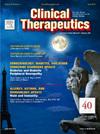一项关于18-44岁年轻人抗抑郁药物使用与卒中风险的全国性队列研究。
IF 3.6
4区 医学
Q2 PHARMACOLOGY & PHARMACY
引用次数: 0
摘要
目的:虽然抗抑郁药的严重不良反应,包括中风,是罕见的,但它们已经引起了越来越多的关注。许多患者在年轻时就开始接受抗抑郁治疗,但他们的中风风险仍未得到充分研究。本研究旨在评估不同年龄组、抗抑郁药类别和治疗适应症与使用抗抑郁药相关的卒中风险。方法:我们采用一种新的用户方法进行了一项队列研究,包括2018年18-44岁的成年人。总的来说,119,751名抗抑郁药服用者和119,751名非服用者按年龄、性别和治疗开始日期进行匹配。选择在WHO解剖治疗化学分类系统中分类为N06A的抗抑郁药。主要终点是治疗开始后180天内的首次卒中事件。发现:使用抗抑郁药与卒中风险增加相关(危险比[HR], 4.33;95%可信区间[CI] 2.30-8.14),尤其是缺血性卒中(HR, 7.02;95% CI 3.18-15.49),高于出血性卒中(HR, 1.63;95% ci 0.60-4.39)。在使用三环抗抑郁药、5 -羟色胺拮抗剂和再摄取抑制剂的人群中观察到卒中风险升高,但在使用选择性5 -羟色胺或5 -羟色胺-去甲肾上腺素再摄取抑制剂的人群中没有观察到卒中风险升高。无精神疾病的抗抑郁药服用者卒中风险显著增高(HR, 5.47;95% CI, 2.58-11.61)或神经系统疾病(HR, 4.10;95% CI, 2.12-7.95)。意义:在18-44岁的成年人中,抗抑郁药的使用与卒中风险增加有关。然而,研究结果受到行政数据的潜在偏差和缺乏对社会经济和地理差异的调整的限制。本文章由计算机程序翻译,如有差异,请以英文原文为准。
A Nationwide Cohort Study on Antidepressant Use and Stroke Risk in Young Adults Aged 18–44 Years
Purpose
Although serious adverse reactions to antidepressants, including stroke, are rare, they have gained increased attention. Many patients start antidepressant treatment at a young age, yet stroke risk among them remains understudied. This study aimed to assess stroke risk associated with antidepressant use across age groups, antidepressant classes, and treatment indications.
Methods
We conducted a cohort study using a new user approach, including adults aged 18–44 years in 2018. Overall, 119,751 antidepressant users and 119,751 non-users were matched by age, sex, and date of treatment initiation. Antidepressants, classified as N06A in the WHO Anatomical Therapeutic Chemical Classification System, were selected. The primary endpoint was the first stroke event within 180 days of treatment initiation.
Finding
Antidepressant use was associated with an increased stroke risk (hazard ratio [HR], 4.33; 95% confidence interval [CI] 2.30–8.14), particularly ischemic stroke (HR, 7.02; 95% CI 3.18–15.49), than hemorrhagic stroke (HR, 1.63; 95% CI 0.60–4.39). Elevated stroke risk was observed among users of tricyclic antidepressants and serotonin antagonist and reuptake inhibitors but not among users of selective serotonin or serotonin-norepinephrine reuptake inhibitors. A significantly higher stroke risk was noted among antidepressant users without psychiatric disorders (HR, 5.47; 95% CI, 2.58–11.61) or neurological disorders (HR, 4.10; 95% CI, 2.12–7.95) than among non-users.
Implications
Antidepressant use was associated with increased stroke risk in adults aged 18–44 years. However, the findings were limited by potential biases in administrative data and a lack of adjustment for socioeconomic and geographic disparities.
求助全文
通过发布文献求助,成功后即可免费获取论文全文。
去求助
来源期刊

Clinical therapeutics
医学-药学
CiteScore
6.00
自引率
3.10%
发文量
154
审稿时长
9 weeks
期刊介绍:
Clinical Therapeutics provides peer-reviewed, rapid publication of recent developments in drug and other therapies as well as in diagnostics, pharmacoeconomics, health policy, treatment outcomes, and innovations in drug and biologics research. In addition Clinical Therapeutics features updates on specific topics collated by expert Topic Editors. Clinical Therapeutics is read by a large international audience of scientists and clinicians in a variety of research, academic, and clinical practice settings. Articles are indexed by all major biomedical abstracting databases.
 求助内容:
求助内容: 应助结果提醒方式:
应助结果提醒方式:


